前面学习了Struts2和Hibernate。
Struts2主要是用来控制业务层面逻辑和显示,告诉你什么时候走哪个action,跑去运行哪个class的什么方法,后面调到哪个jsp。
Struts2需要配置的struts.xml, 配置对应的action和jsp表单页面。
struts2包含的主要功能有哪些: 参数自动封装、参数自动转换、输入校验、拦截器、OGNL、值栈、actionContext、标签、国际化、上下文传载等。
Hibernate主要是让程序员少做Mysql操作 ,通过操作POJO这个Javabean实体来来操作数据表。---让程序员集中精力在业务上。
hibernate需要配置xxx.hbm.xml 负责映射POJO类和数据表 hibernate.cfg.xml负责连接数据库和一些数据库配置。
配置了上面两个xml就可以使用hibernate,里面也有一些特定的类:Configuration SessionFactory Session Transaction
那么Spring是用来做什么?希望 用过这个学习能明白Spring是用来干啥的,简单例子是啥?
下面文章基本是学习并参考了他们的帖子,自己按照所学实现后写的记录。想看原文请看最后附录连接!
以前也看过几次Spring,不过工作中没有用就这样忘掉了。但是其中有几个重要概念:控制反转IOC(Inverse of control),面向切面编程AOP(Aspect Oriented Programming),依赖注入DI(Dependency Injection),JavaBean等概念。现在也基本忘了。也不知道是用来干嘛的。学完后一定要能理解这个概念是用来干嘛的。
下面先来给一个例子:该添加的Jar包添加进去。
一、什么是IOC
在Spring里面也有一个配置文件:applicationContext.xml 名字不固定。就是xxx.xml用来配置bean的。
下面看我们的bean.xml, 一般直接放在src路径下:
1 <?xml version="1.0" encoding="UTF-8"?> 2 <beans xmlns="http://www.springframework.org/schema/beans" xmlns:xsi="http://www.w3.org/2001/XMLSchema-instance" 3 xmlns:context="http://www.springframework.org/schema/context" xmlns:util="http://www.springframework.org/schema/util" 4 xmlns:jee="http://www.springframework.org/schema/jee" xmlns:tx="http://www.springframework.org/schema/tx" 5 xmlns:jpa="http://www.springframework.org/schema/data/jpa" xmlns:mvc="http://www.springframework.org/schema/mvc" 6 xsi:schemaLocation=" 7 http://www.springframework.org/schema/beans http://www.springframework.org/schema/beans/spring-beans-3.2.xsd 8 http://www.springframework.org/schema/context http://www.springframework.org/schema/context/spring-context-3.2.xsd 9 http://www.springframework.org/schema/util http://www.springframework.org/schema/util/spring-util-3.2.xsd 10 http://www.springframework.org/schema/jee http://www.springframework.org/schema/jee/spring-jee-3.2.xsd 11 http://www.springframework.org/schema/tx http://www.springframework.org/schema/tx/spring-tx-3.2.xsd 12 http://www.springframework.org/schema/data/jpa http://www.springframework.org/schema/data/jpa/spring-jpa-1.3.xsd 13 http://www.springframework.org/schema/mvc http://www.springframework.org/schema/mvc/spring-mvc-3.2.xsd"> 14 <!-- 上面这些是标准添加 --> 15 16 <!-- 配置bean Id 和对应的class,一个bean一个Id对应一个Class --> 17 <bean id = "computer" class="bean.Computer"> 18 <!-- property 用来配置类的属性 --> 19 <property name="brand" value="HP"></property> 20 <property name="colour" value="Red"></property> 21 </bean> 22 23 </beans>
上面我们在Spring容器applicationContext.xml(暂时可以这么理解)中把这个类注册为javaBean。
注意上面说的Spring容器这个概念。
然后看我们的JavaBean类Computer.java
1 package bean; 2 3 public class Computer { 4 5 private String brand; 6 private String colour; 7 /** 8 * @return the brand 9 */ 10 public String getBrand() { 11 return brand; 12 } 13 /** 14 * @param brand the brand to set 15 */ 16 public void setBrand(String brand) { 17 this.brand = brand; 18 } 19 /** 20 * @return the colour 21 */ 22 public String getColour() { 23 return colour; 24 } 25 /** 26 * @param colour the colour to set 27 */ 28 public void setColour(String colour) { 29 this.colour = colour; 30 } 31 /* (non-Javadoc) 32 * @see java.lang.Object#toString() 33 */ 34 @Override 35 public String toString() { 36 return "Computer [brand=" + brand + ", colour=" + colour + "]"; 37 } 38 }
添加我们的测试类:
1 package test; 2 3 import org.springframework.context.ApplicationContext; 4 import org.springframework.context.support.ClassPathXmlApplicationContext; 5 6 import bean.Computer; 7 8 public class TestComputer { 9 10 public static void main(String[] args) { 11 //定义我们配置的bean.xml 12 String conf = "applicationContext.xml"; 13 //加载bean.xml 14 ApplicationContext ac = new ClassPathXmlApplicationContext(conf); 15 //通过ApplicationContext来直接获取对象,不再需要new一个实例 16 Computer computer = ac.getBean("computer", Computer.class); 17 Computer computer1 = ac.getBean(Computer.class); 18 19 System.out.println(computer); 20 System.out.println(computer1); 21 } 22 23 }
运行输出:
Apr 03, 2019 4:55:19 PM org.springframework.context.support.ClassPathXmlApplicationContext prepareRefresh
INFO: Refreshing org.springframework.context.support.ClassPathXmlApplicationContext@61e717c2: startup date [Wed Apr 03 16:55:19 CST 2019]; root of context hierarchy
Apr 03, 2019 4:55:19 PM org.springframework.beans.factory.xml.XmlBeanDefinitionReader loadBeanDefinitions
INFO: Loading XML bean definitions from class path resource [applicationContext.xml]
Computer [brand=HP, colour=Red]
Computer [brand=HP, colour=Red]
至此,这个项目就完成了,大家有没有发现什么!
我们Computer类我们没有自己实例化啊,怎么可以直接用?其实整个流程是这样的,
我们刚开始写了个Computer类;
然后在applicationContext.xml文件,即,Spring容器,把这个类注册到这个容器中,这就是一个JavaBean,并且为其属性设置了值;
接下来在TestCompute类中,实例化了这个Spring容器(不理解这句话),从这个容器中拿到Computer的类对象,并且输出。
在这个过程中我们没有自己实例化Computer类,是Spring容器帮我们实例化了,这个实例化的举动由我们程序员交给了Spring容器来实现,这就是控制反转,IOC。
所以说,所谓的控制反转,就是在Spring中我们不再需要去自己new一个实例对象,在配置好的bean.xml下,我们可以直接get对象。
到此,我们可以知道Spring的第一个功能就是帮我们创建实例。
当然Spring也同样可以通过注解来进行上面的配置,不通过bean.xml来配置。
这个地方有个需要注意的,就是一个类里面的属性不是基本数据类型,而是其他类,那么通过Spring创建这个类的时候,里面的类属性也会被赋值。(但是这个属性类是怎么被创建的呢???)
二、依赖注入(DI)
依赖注入(DI):spring创建对象A时,会将对象A所依赖的对象B也创建出来,并自动注入到对象A中。
依赖:(has a) 有一个的意思,比如类A中有一个类B,那么就说A依赖B。 继承,实现(is a)
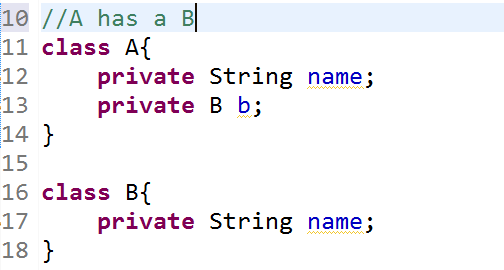
而我们说的依赖注入,就是当创建A对象时,同时会将B对象给创建,并自动注入到对象A中去,也就说,我只叫spring给我A对象,但是A中可以使用B对象了。这个有很大的用处,但如何去实现依赖注入功能呢?下面有个例子:
1 package dao; 2 3 public class UserDao { 4 5 public void addUser(){ 6 System.out.println("UserDao。。。。。"); 7 System.out.println("依赖注入。。。。。"); 8 } 9 10 } 11 12 package service; 13 14 import dao.UserDao; 15 16 public class UserService { 17 18 private UserDao userDao; 19 20 /** 21 * @param userDao the userDao to set 22 */ 23 public void setUserDao(UserDao userDao) { 24 this.userDao = userDao; 25 } 26 27 public void addUser(){ 28 System.out.println("UserService。。。。。。。"); 29 userDao.addUser(); 30 } 31 32 }
UserService中有使用userDao对象,这个我们都很熟悉的使用伎俩,service层调用dao层的方法。按照往常我们的写法,在service中需要自己new出UserDao对象,但是在spring中就不需要了,一切对象都让spring帮我们创建。
ApplicationContext.xml
1 <?xml version="1.0" encoding="UTF-8"?> 2 <beans xmlns="http://www.springframework.org/schema/beans" xmlns:xsi="http://www.w3.org/2001/XMLSchema-instance" 3 xmlns:context="http://www.springframework.org/schema/context" xmlns:util="http://www.springframework.org/schema/util" 4 xmlns:jee="http://www.springframework.org/schema/jee" xmlns:tx="http://www.springframework.org/schema/tx" 5 xmlns:jpa="http://www.springframework.org/schema/data/jpa" xmlns:mvc="http://www.springframework.org/schema/mvc" 6 xsi:schemaLocation=" 7 http://www.springframework.org/schema/beans http://www.springframework.org/schema/beans/spring-beans-3.2.xsd 8 http://www.springframework.org/schema/context http://www.springframework.org/schema/context/spring-context-3.2.xsd 9 http://www.springframework.org/schema/util http://www.springframework.org/schema/util/spring-util-3.2.xsd 10 http://www.springframework.org/schema/jee http://www.springframework.org/schema/jee/spring-jee-3.2.xsd 11 http://www.springframework.org/schema/tx http://www.springframework.org/schema/tx/spring-tx-3.2.xsd 12 http://www.springframework.org/schema/data/jpa http://www.springframework.org/schema/data/jpa/spring-jpa-1.3.xsd 13 http://www.springframework.org/schema/mvc http://www.springframework.org/schema/mvc/spring-mvc-3.2.xsd"> 14 <!-- 上面这些是标准添加 --> 15 16 <!-- 用来创建UserDao对象--> 17 <bean id = "UserDao" class = "dao.UserDao"></bean> 18 19 <!-- 创建UserService对象 20 property对其对象中进行依赖注入过程,底层将执行setter()方法 21 name在UserService对象中UserDao对象的属性名 22 ref创建userDao对象的beanId --> 23 <bean id = "UserService" class = "service.UserService"> 24 <property name="userDao" ref="UserDao"></property> 25 </bean> 26 27 28 29 </beans>
过程如下:先创建UserService对象,然后在根据property中的ref找到userDaoId并创建UserDao对象,然后根据property中的name,通过setter方法注入,这样就完成了依赖注入。测试如下:
1 package service; 2 3 import org.springframework.context.ApplicationContext; 4 import org.springframework.context.support.ClassPathXmlApplicationContext; 5 6 public class Test { 7 8 public static void main(String[] args) { 9 10 String conf = "applicationContext.xml"; 11 12 ApplicationContext ac = new ClassPathXmlApplicationContext(conf); 13 14 UserService userService = ac.getBean("UserService", UserService.class); 15 16 userService.addUser(); 17 } 18 19 }
运行结果如下:
Apr 04, 2019 4:38:00 PM org.springframework.context.support.ClassPathXmlApplicationContext prepareRefresh
INFO: Refreshing org.springframework.context.support.ClassPathXmlApplicationContext@61e717c2: startup date [Thu Apr 04 16:38:00 CST 2019]; root of context hierarchy
Apr 04, 2019 4:38:00 PM org.springframework.beans.factory.xml.XmlBeanDefinitionReader loadBeanDefinitions
INFO: Loading XML bean definitions from class path resource [applicationContext.xml]
UserService。。。。。。。
UserDao。。。。。
依赖注入。。。。。
所谓的依赖注入:我们JavaBean中的参数都是通过setXXX()进去的,特别是当XXX不是一个基本类型数据,而是一个接口的时候,我们set进去就应该是它的实现子类。假如有多个实现子类,我们set进去是哪个就是哪个。这个就是依赖注入。所以从这个角度来看,依赖注入并不需要我们来做什么,就是一个常规 的赋值。
依赖注入也分两种方式:1:通过构造器注入; 2:通过setter方式注入
之前讲的那个依赖注入其实也属于属性依赖注入这一范畴中,在最开始我们演示IOC(控制反转)也就是spring帮我们创建实例时,那只是通过无参构造方法进行创建,那么在实际开发中,这样创建肯定是不行的,所以我们需要在spring的配置文件中配置一些属性信息,使spring帮我们创建时,可以直接将对象的一些属性也注入进去,有两种方法:
通过构造方法注入

不管是普通属性还是引用数据,都可以通过构造方法进行注入。通过setter方法进行注入,
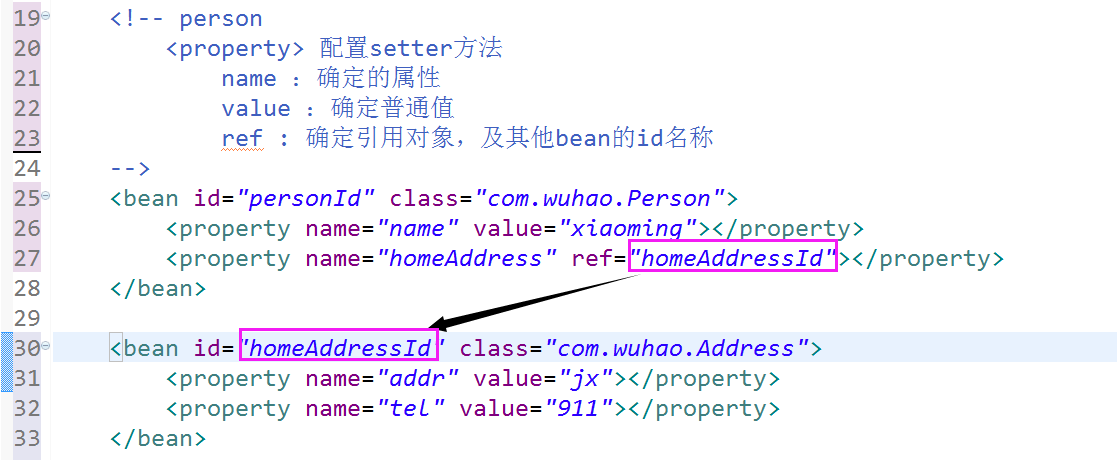
通过setter方法对普通属性和引用属性进行注入,那么要是创建的对象中有集合呢?那该如何进入注入?
集合的注入List、Map、Set、数组、Properties等。
List
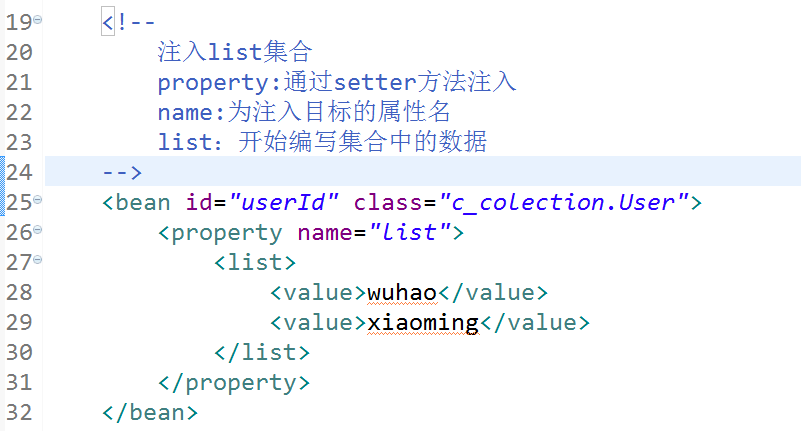
set
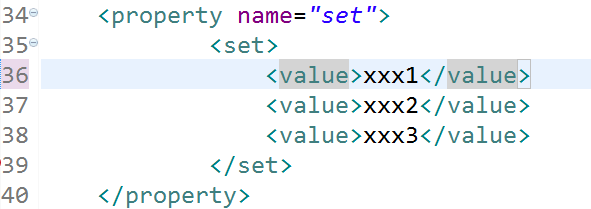
map

数组

propertyis

注意:properties这种类型存放形式跟map差不多,以key和value进行存放的,
![]()
到这里,基本上就把所有能够注入的属性类型都讲解完了,注入的类型基本上分为三块,普通类型,引用类型和集合。下面在讲一种基于注解来注入各种,因为基于xml感觉很麻烦。
属性依赖注入基于注解
注解格式:@xxx
使用注解:必须对使用注解的地方进行扫描,不然注解没用。而扫描需要做两件事
1、添加名称空间,
在我们找配置文件中约束的位置那:spring-framework-3.2.0.RELEASE\docs\spring-framework-reference\html\xsd-config.html 找到context的名称空间。


2、扫描指定的目录,

注解:
1、@Component 替代 <bean id="" class=""> 可以配置任意bean,在所在类上面添加该注解即可,
@Component("userId") userId相当于bean中的id属性值

2、 这三个就跟使用@Component是一样的,但是为了更好的体现三层架构,就有了这三个注解
@Controller 修饰web层中的类。
@Service 修饰service层的类
@Repository 修饰dao层的类
两种方式,一种不声明名称,一种声明名称
@Controller("xxx") @Controller
如果声明了名称,那么在别的地方引用的话,就可以使用@Autowired或@Autowired与@Qualifier的组合 或直接使用@Resource按照名称注入
如果没有声明名称,那么在别的地方引用的话,只能使用@Autowired 来进行注入
3、属性注入
普通属性
@Value @Value("") 给普通属性注入属性值
引用属性
@Autowired 按默认类型进行注入
@Qualifier("") 按照名称注入
如果使用了@Qualifier这个注解,那么就需要两个一起使用才能生效。如果只使用@Autowired,那么写不写@Qualifier都可以
引用属性
@Resource 直接按照名称注入,与上面两个注解一起使用是等效的
@Resource(name="xxx")
4、使用
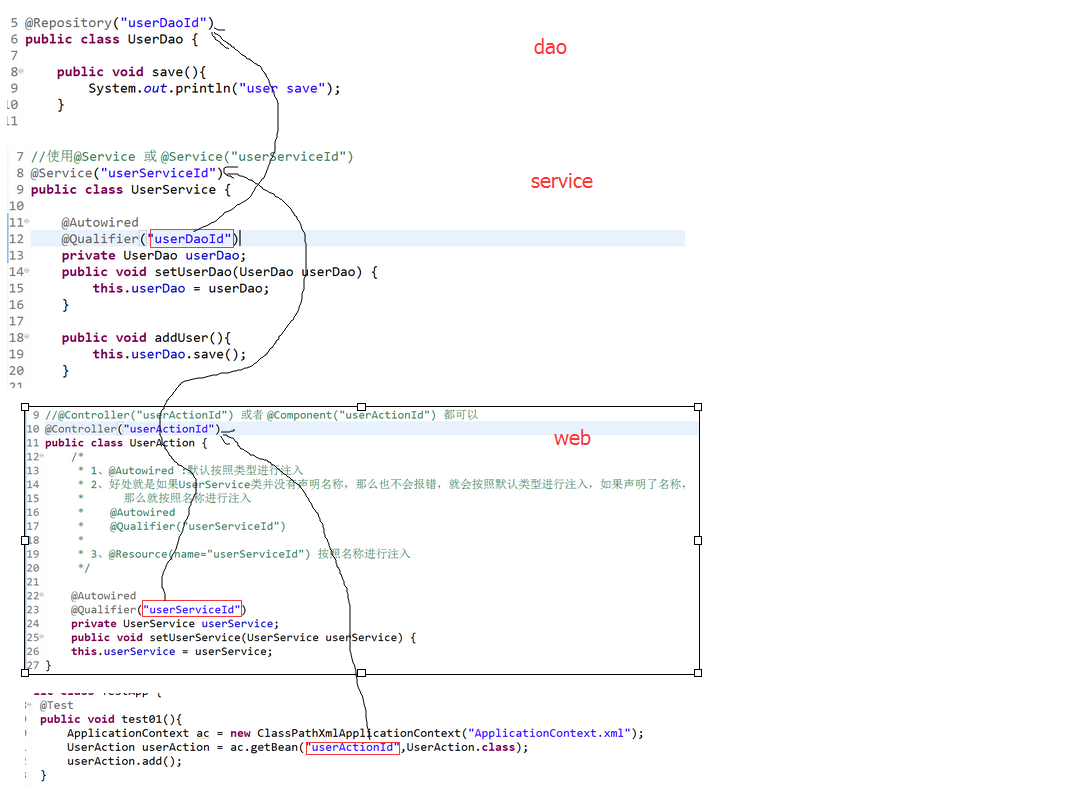
5、其他注解
@Scope("prototype") 作用域注解(spring帮我们创建的bean实例的作用域,在下面会讲解到)
@PostConstruct 修饰初始化
@PreDestory 修饰销毁
最后两个用的不多,掌握前面的即可。
细细回想上面的两个概念:控制反转(IOC)和依赖注入(DI)。
https://www.cnblogs.com/whgk/p/6616593.html---